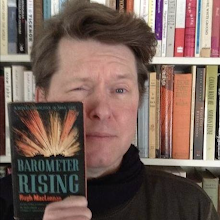
A bit of a change of pace this month as I work toward a deadline. Expect fewer words and more pictures – a bit like the revamped Maclean's or Canwest's treatment of the old Southam papers.
Let's begin the visual feast with six books by man of the week Arthur Stringer. The most interesting, I think, is Without Warning (New York: Grosset & Dunlap, 1924), a novel he co-wrote with Russell Holman. The project began as a publicity gimmick put together by Paramount, which released a film without a title – actually, it was called The Story Without a Name – and encouraged moviegoers to submit suggestions. The plot centres on an idealistic young scientist who invents a death ray, is kidnapped by pirates, but escapes when he is able to create a second death ray out of old junk. An attractive cover, I suppose, but where's that death ray?

The Prairie Child. Indianapolis: Bobbs-Merrill, 1922.The standard line on Stringer is that he's remembered for his Prairie Trilogy: Prairie Mother (1915), Prairie Wife (1920) and Prairie Child. This isn't at all true; Stringer is a forgotten writer. The last any of these titles saw print was in 1950, when two appeared in a bind-up called The Prairie Omnibus. To find all three, you have to go back even farther, to 1939, and another bind-up, The Prairie Stories.
Power. Indianapolis: Bobbs-Merrill, 1925.The story of John Jusk, a determined man who makes his fortune in the railroads. Though it would make for an interesting book, I'm assuming that's not our hero on the cover.Power was hated by Frederick Philip Grove, Stringer's rival in the area of prairie fiction. Grove's review for Canadian Bookman misidentifies the novel as an 'autobiography', and concludes: 'Whenever John Jusk says a thing, he does so "with his jaws clamped". That is sufficient advertisement for one class of readers; a sufficient warning for another.'Wolf Woman. Indianapolis: Bobbs-Merrill, 1927.The daughter of a bush ranger, Dynamite Mary is 'three-quarters timber wolf and one-quarter angel'. Hers is a simple, uncomplicated until one day she is 'transported suddenly out of the forests of Canada to the fever and tumult of life on the banks of the Hudson and the castled shores of Long Island.'Fun.

Marriage by Capture. Indianapolis: Bobbs-Merrill, 1933.Stranded in the Canadian wilderness, a beautiful young heiress believes she's found rescue in a mysterious man, only to find that he refuses to help her return to civilization.Creepy.

The Wife Traders: A Tale of the North. Indianapolis: Bobbs-Merrill, 1936.In this fantasy set four decades in the future, citizens of 'Suburbia' gather to play a strange game in which car keys are placed in a bowl and... Well, not really, though the novel does deal with adultery, a topic that prevented magazine serial sales.Reprinted by Harlequin in 1955, to this day The Wife Traders remains the very last Stringer title to have appeared in print.
Related posts:











